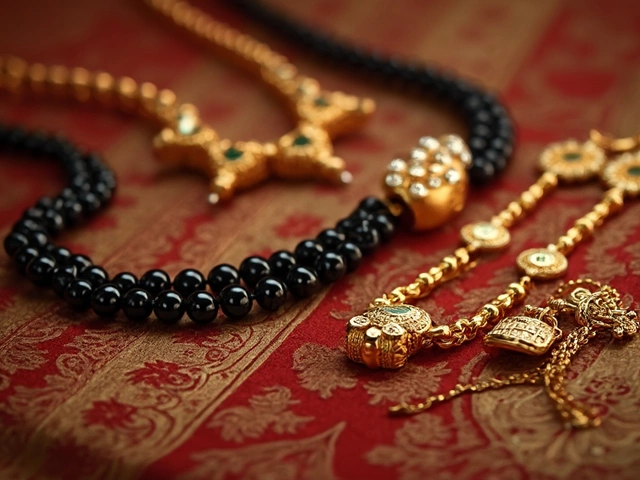Religious Symbols in Indian Jewelry: Meaning, Styles & Buying Tips
Religion and jewellery have been linked in India for centuries. From the tiny Om charm on a gold chain to a majestic Ganesha pendant, each piece tells a story and carries a belief. If you’re curious about why these symbols matter and how to pick the right one, you’re in the right place.
Why People Wear Religious Symbols
Most people wear a symbol for three simple reasons – faith, fashion, and family tradition. An Om talisman can serve as a daily reminder of inner peace, while a Lakshmi locket often represents hopes for wealth and prosperity. In many families, a particular design is passed down through generations, turning a simple necklace into a treasured heirloom.
Popular Symbols and Their Meanings
Om: The sound of the universe. A small Om charm on a silver chain is subtle yet powerful.
Ganesha: The remover of obstacles. Ganesha pendants are often worn during new ventures or exams.
Krishna Flute: Symbolises love and divine play. It’s a favorite among those who follow the Bhakti tradition.
Hanuman: Represents strength and devotion. Many people wear a Hanuman badge on a bracelet for protection.
Om Namah Shivaya mantra: Often engraved on rings, it calls for inner transformation and courage.
These designs appear in gold, silver, or plated metals, and sometimes include semi‑precious stones like lapis or turquoise that match the symbol’s energy.
How to Choose Authentic Pieces
First, check the hallmarks. Look for the BIS (Bureau of Indian Standards) stamp on gold – it guarantees purity and protects you from counterfeit pieces. For silver, a ‘925’ or ‘800’ mark works the same way. When buying a religious charm, pay attention to the craftsmanship. A clean finish, even engraving, and sturdy prongs mean the piece will last longer.
If you shop online, read the product description carefully. Look for details about the metal type, weight, and any gemstone used. Good sellers also provide clear photos from multiple angles.
Caring for Your Spiritual Jewellery
Gold and silver need regular cleaning to keep their shine. A soft cloth and mild soap work for most items, but avoid harsh chemicals that can damage the metal or remove any patina you might like. For pieces with gemstones, check if the stone is porous – some need special cleaning solutions.
Store your jewellery in a dry box or a separate pouch to prevent scratches. If you wear a necklace daily, consider a backup chain so the main piece can rest and avoid constant wear.
Current Trends
Minimalist designs are big right now. Tiny Om studs or a thin Ganesha pendant on a delicate chain let you wear your faith without looking over‑the‑top. At the same time, traditional temple jewellery – heavy gold ornaments with detailed carvings – is seeing a resurgence for weddings and festive occasions.
Mixing metals is also popular. A silver chain with a gold‑filled pendant blends modern style with classic symbolism. Pair your spiritual piece with casual outfits or dress it up for a ceremony – the flexibility is part of the appeal.
Whether you’re buying your first religious charm or adding to a growing collection, focus on meaning, quality, and personal connection. The right piece not only looks good but also feels right every time you touch it.
Kirpan and the Five Ks of Sikhism: What You Need to Know
The Kirpan is a significant symbol in Sikhism, serving as one of the Five Ks that Khalsa Sikhs are expected to uphold. This article delves into the history and meaning of the Kirpan, its cultural significance, and how it fits into modern Sikh identity. Understanding the Kirpan can provide deeper insights into Sikh values and spirituality. Practical tips on wearing and respecting this important religious artifact are also discussed.
The Kirpan: Exploring its Importance in Sikhism
The Kirpan, one of the Five Ks of Sikhism, is more than just a ceremonial dagger. It represents compassion and one's duty to stand against oppression. Understanding the Kirpan helps appreciate its role in Sikh faith and how it symbolizes moral responsibility. This article delves into the significance and the principles behind wearing it.
The Kirpan's Role in Sikh Commitment to Protection
The Kirpan, a ceremonial sword or dagger, is more than just a weapon for Sikhs—it's a profound symbol of their commitment to protect others. This sacred object embodies the duty of defending justice and those in need. For Sikhs, carrying the Kirpan is a practice deeply rooted in their religious beliefs, representing courage and respect for life. While it may raise questions in communities unfamiliar with it, understanding its significance sheds light on Sikh values.
Understanding Kirpan: Can Non-Sikhs Wear It?
The kirpan, a ceremonial dagger, is an important symbol of faith for Sikhs around the world. While it is traditionally worn by baptized Sikhs, questions arise about whether non-Sikhs can wear the kirpan. This article explores the religious and cultural nuances surrounding the kirpan, offering insights into its historical significance and the perspective of Sikh communities. Find out what considerations and legal aspects come into play for those outside the Sikh faith interested in carrying a kirpan.








